Resistance, Removal, and the Settler State: The Pre-History of Knox College
The History of the Native Territory we Currently Call Western Illinois. We used a variety of sources to compile this timeline. Check out our class bibliography here.
MATERIAL CULTURE
NATIVE HISTORY
U.S.CONTEXT
THE FOUNDERS
U.S. ContextEnd of the American Revolutionary War
The end of the Revolutionary War meant very little at the time for the Native nations living in and around what is currently Galesburg, Illinois. The Dakota, Kickapoo, Peoria, Meskwaki, Miami, Potawatomi, and Sak, governed, farmed, and managed their lands in this region, as well as trading with Europeans, primarily from France and Britain.

U.S. ContextNotes on the State of Virginia Published by Thomas Jefferson
Jefferson’s sole published book, outlining his specific philosophy and ideology regarding the treatment and indoctrination of the Native Nations. In it, he stated his belief that the Native Americans could become a part of U.S. society provided that they adapted their lifestyle to the U.S. and surrendered land.

U.S. ContextThe Northwest Ordinance
This land ordinance represented the United States’ claim to land in the Midwest after the Revolutionary War. The lands included in the ordinance were the places we currently know as Ohio, Indiana, Illinois, Michigan, Wisconsin, and Minnesota. Plans for the future development of these lands were created by white politicians without Native input. The United States had little-to-no influence in these places when the ordinance was passed; these were Native territories.

Native NationsBattle of Waapaahšiki (St. Clair’s Defeat)
As the United States began expanding westward, this battle took place between the Taawaawa Siipiiwi nations and their allied forces along the Maumee River. The nations and their allies claimed victory against General Arthur St. Clair humiliating both the General and the United States military. Overall, the battle showcased the perseverance of the Taawaawa Siipiiwi nations against constant harassment by the United States government (Aacimotaatiiyankwi, 2014).

Native NationsBattle of the Taawaawa Siipiiwi (Fallen Timbers)
A battle between the Myaamia and their allies, and the United States. During the battle, British forces closed the doors to Fort Miami, which signified their lack of support for, and weakening alliance with, Native people. Afterwards, Mihšihkinaahkwa worked towards peace with the U.S. and the Myaamia people were pushed further west (Aacimotaatiiyankwi, 2016).

Material CultureEli Whitney Invents the Cotton Gin
The invention of the cotton gin made it possible for Southern enslavers to increase the amount of cotton enslaved laborers produced. This resulted in many Southerners wanting to expand further west in order to get more land to produce more cotton, resulting in the displacement of Native Nations. Simultaneously, the increase in land and production increased the demand for enslaved people to work on the cotton plantations.
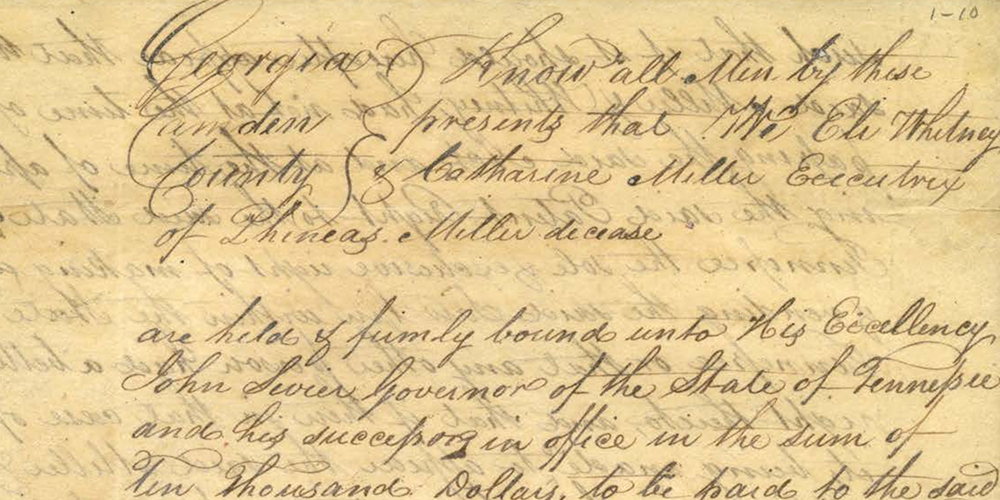
Native NationsTreaty of Greenville
This treaty created a boundary line between Native territory and the land claimed by the United States in what is currently Ohio and other areas of the Midwest. The Myaamia, Wyandotte, Shawnee, Lenape, Ottawa, Ojibwa, Potawatomi, Kickapoo, Kaskaskias, Eel River, and Weas ceded lands to the United States, which opened those areas for white settlement. Despite the treaty establishing a boundary for settlement, white settlers continued to move further and further west, disregarding the treaty and putting increased pressure on Native nations.

Native NationsTreaty with the Kaskaskia
A treaty between William Henry Harrison, the Governor of the Indiana Territory, and the Kaskaskia nation ceding all land in Illinois in exchange for 350 acres of land near their village of Kaskaskia in Missouri. The Kaskaskia who signed the treaty were a combination of the Kaskaskia, Mitchigamia, Cahokia, and Tamarois nations. The United States promised to build a house for the chief, fence in at most 100 acres of farming land, provide protection against other Native nations and assist in building a Catholic church and provide funds for a priest. The Kaskaskia kept the right to hunt on the land that they ceded to the U.S.
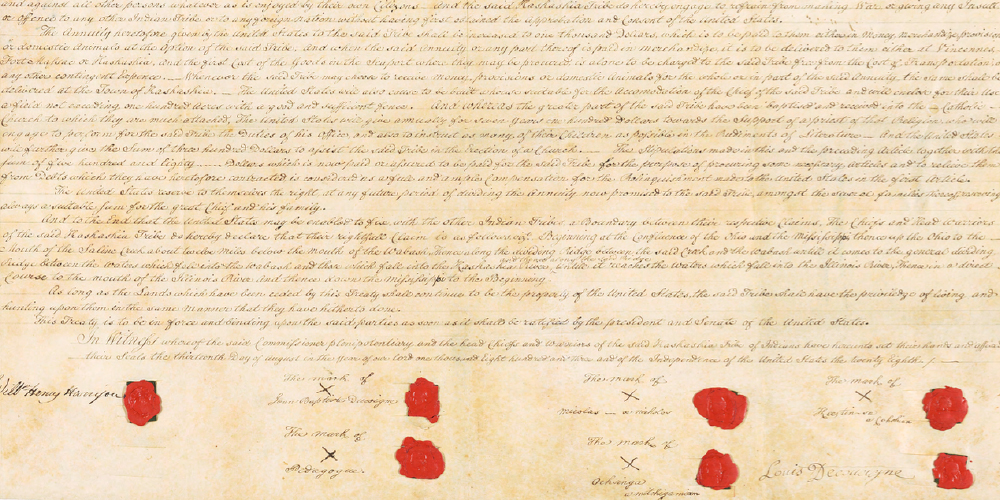
Native NationsTreaty of St. Louis (Sauk and Meskwaki)
In 1804, five head men of the Sauk and Meskwaki nation arrived in St. Louis to settle a dispute. Three white settlers had been murdered by four Sauk hunters for illegally living on Sauk land. The Sauk and Meskwaki men were sent to St. Louis to appease the U.S. government. William Henry Harrison, Governor of Indiana Territory, saw the head men’s visit as an opportunity to get them to cede Sauk and Meskwaki lands. The head men, who lacked the authority to sign any agreement, signed a treaty in secret, ceding fifty million acres of land without the permission of the Tribal Council.
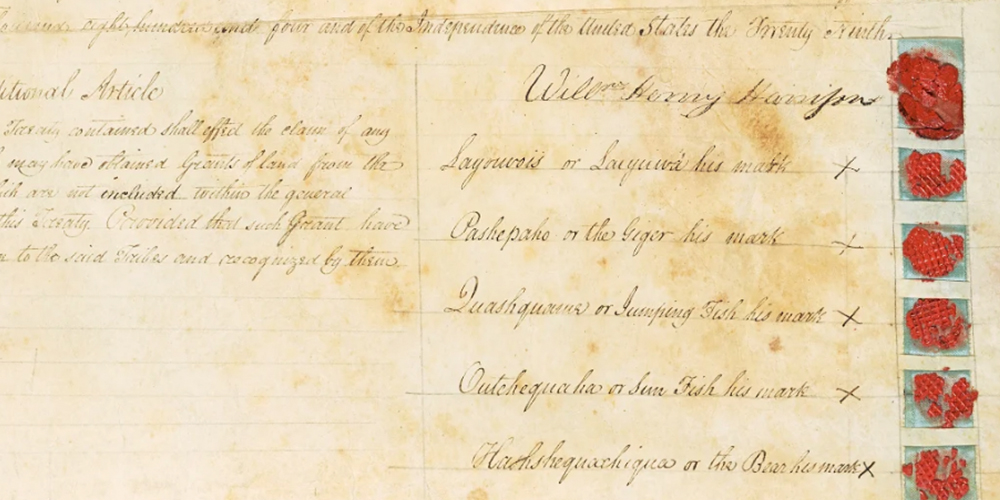
Native NationsFort Madison is Constructed
This fort, built on the western side of the Mississippi in Iowa, caused many Sauk and Meskwaki to believe that the treaty of 1804 was nullified. Many believed that the chiefs and headsman who signed the treaty were not qualified to do so. One of the main protesters against the treaty was Black Hawk.
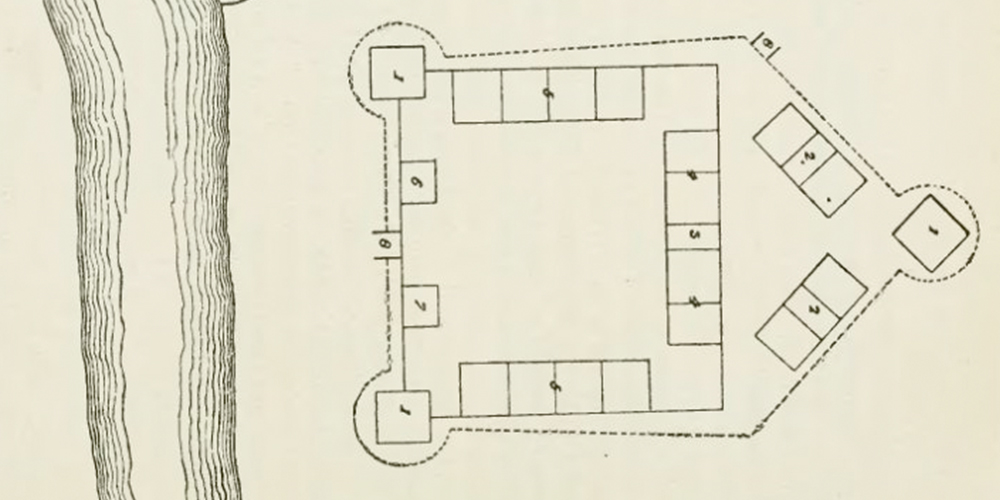
U.S. ContextBattle of Tippecanoe
This was the last solitary battle of Tecumseh’s confederacy. This battle was a decisive victory for US forces at Prophetstown, allowing William Henry Harrison to go from a territorial governor to a national figure. An alliance between the confederacy and the British government was re-established during the War of 1812. This fueled the popularity of William Henry Harrison, who had negotiated the Treaty of Vincennes, Treaty of Grouseland, and many other critical and controversial treaties in the Midwest.
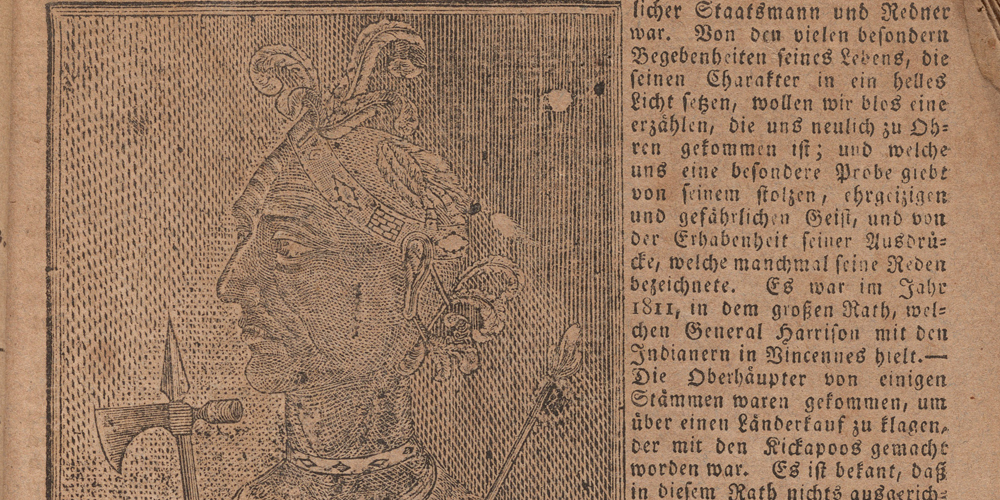
U.S. ContextBattle of Horseshoe Bend
The last major battle involving the Red Sticks faction of the Creek nation, who were inspired by Tecumseh and rebelled against Creek leadership. This battle gave Andrew Jackson national notoriety in the U.S. It was the first significant win of his military career, marking the end of the Creek civil war.
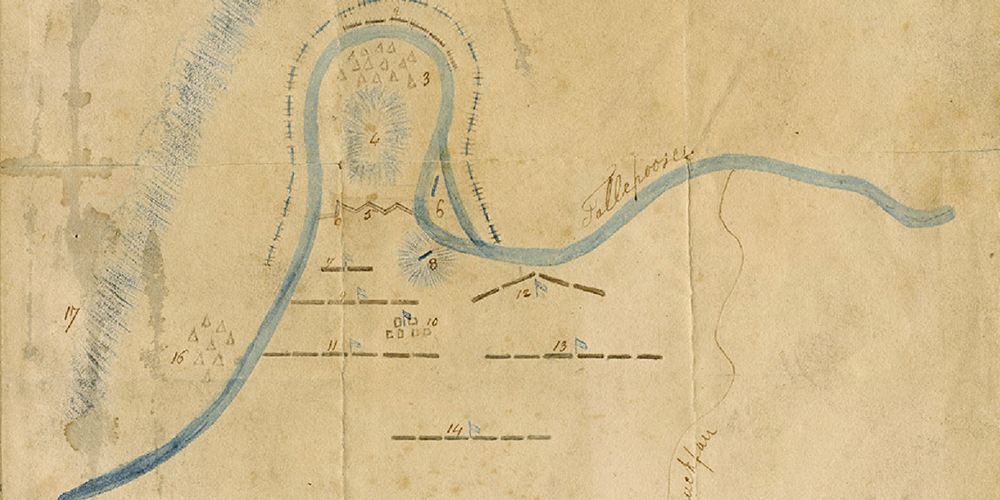
U.S. ContextFort Jackson Treaty
The treaty that ended the Creek civil war. Andrew Jackson used military pressure to force the Creek nation to surrender 22 million acres of land to the United States. (Jackson faulted his allies for having not prevented the Red Sticks faction from developing in the first place.) The treaty was the first tangible example of Jackson’s preference for policies that removed Native people from their lands, as opposed to Jefferson’s preference for assimilation and limited cooperation.
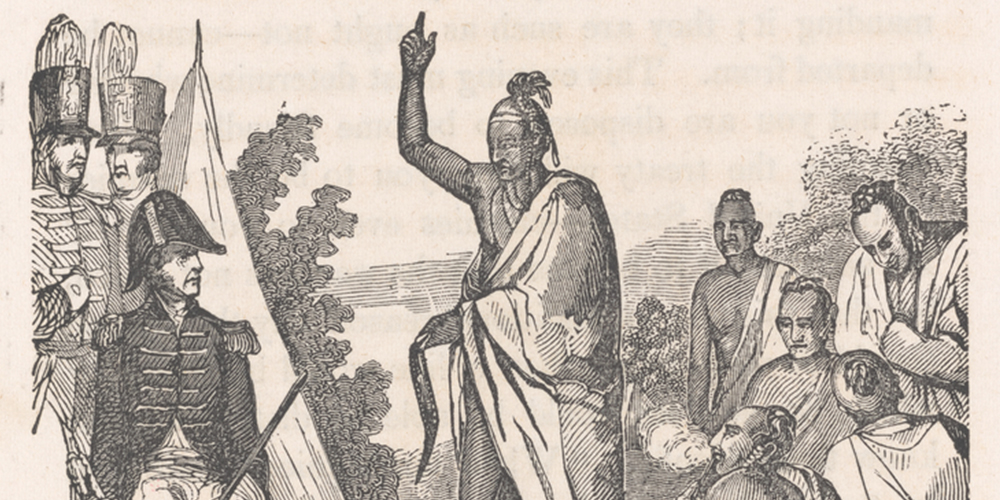
U.S. ContextTreaty of Ghent
The treaty that concluded the War of 1812. One of its clear tenets was that all land captured during the war would be returned to its original owners. This was not evenly applied to Native nations, however. The Creek’s land was never returned, and they did not receive compensation until 1962. The provisions of the treaty reflect Jackson’s influence on policy.
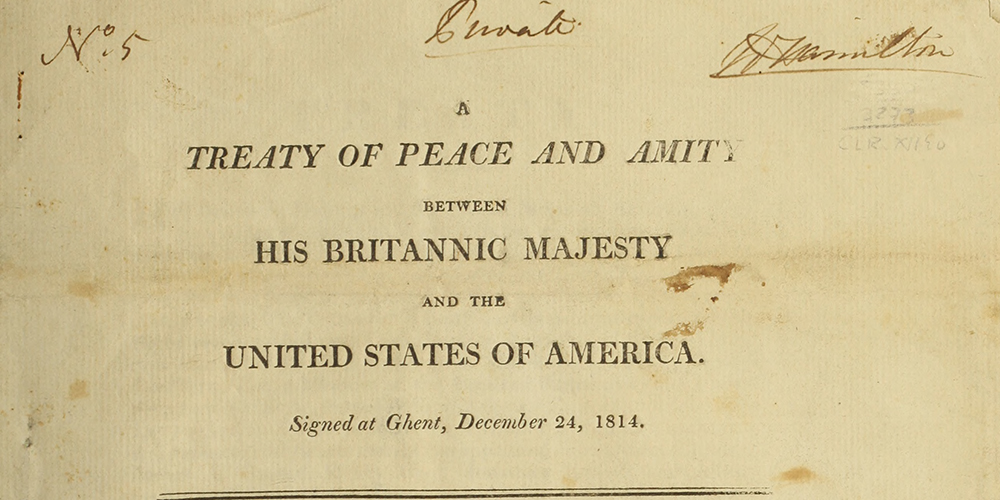
Native NationsFurther Westward Expansion
After the War of 1812, many nations, including the Kickapoo, made peace treaties with the U.S. government. In the years directly after the war, settlers began encroaching on Native nations' lands, ignoring treaty lines and moving into Native hunting grounds. In retaliation, the Kickapoo began a campaign of camp raids and sabotage against surveyors and settlers in what we currently call Illinois. Though at first finding some success, eventually America’s defenses became too strong. With westward expansion growing rapidly and with other Nations agreeing to move west, the Kickapoo were left with no other choice but to strike a deal with the U.S. Government.
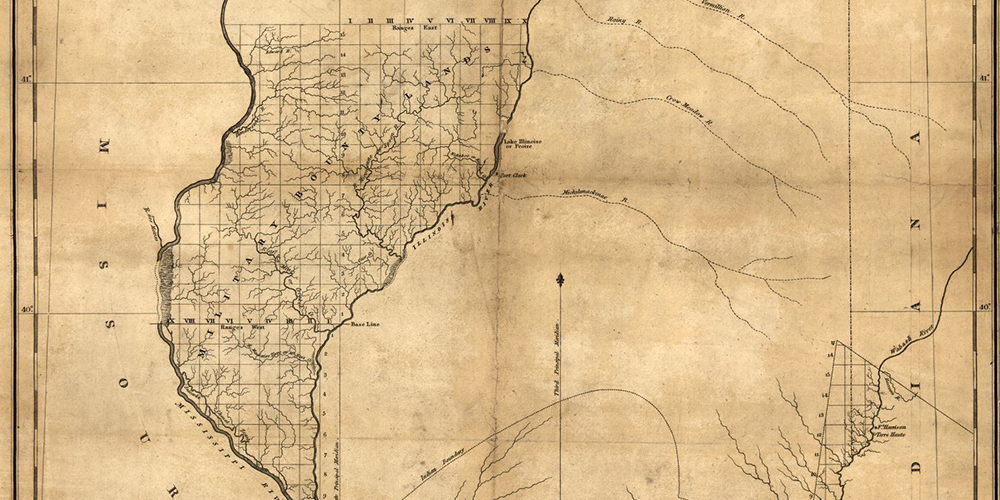
U.S. ContextBounty Lands set aside by Congress for the Veterans of the War of 1812
After the war of 1812, Congress set aside what they called Bounty Lands which had grants for land for veterans of the war of 1812. This was commonly called the military tract of land as there were armies stationed on it before settlers could come claim it. This land was throughout Illinois and would allow for the founders to later buy the land that Knox College and Galesburg would eventually be built on.
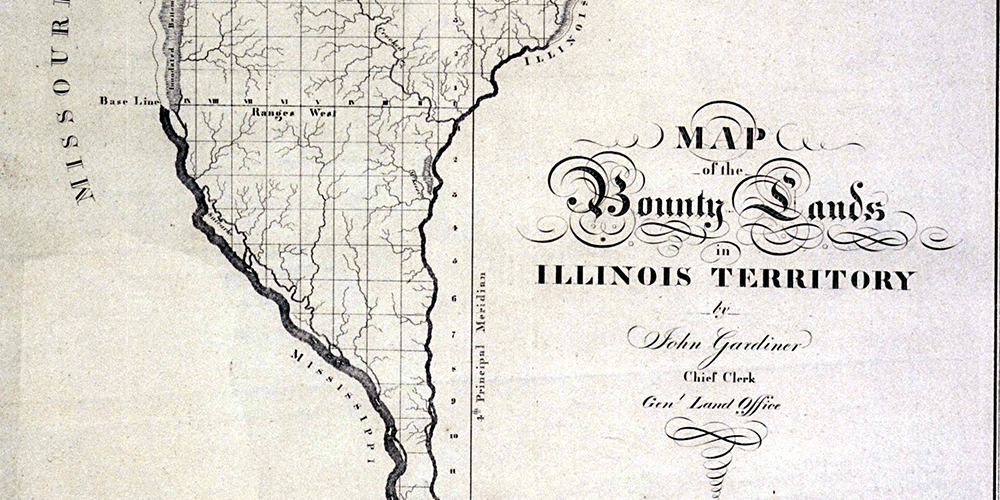
Native NationsTreaty of St. Louis (Council of Three Fires)
Treaty signed between the U.S. government and the Council of Three Fires (Ojibwe, Odawa, and Potawatomi nations) in which they “relinquish[ed], to the United States, all their right, claim, and title” to the land that is currently Galesburg, while crucially still retaining hunting and fishing rights on the land. Ownership of this land was previously also ceded by the Sauk and Meskwaki nations in the Treaty of St. Louis (1804).
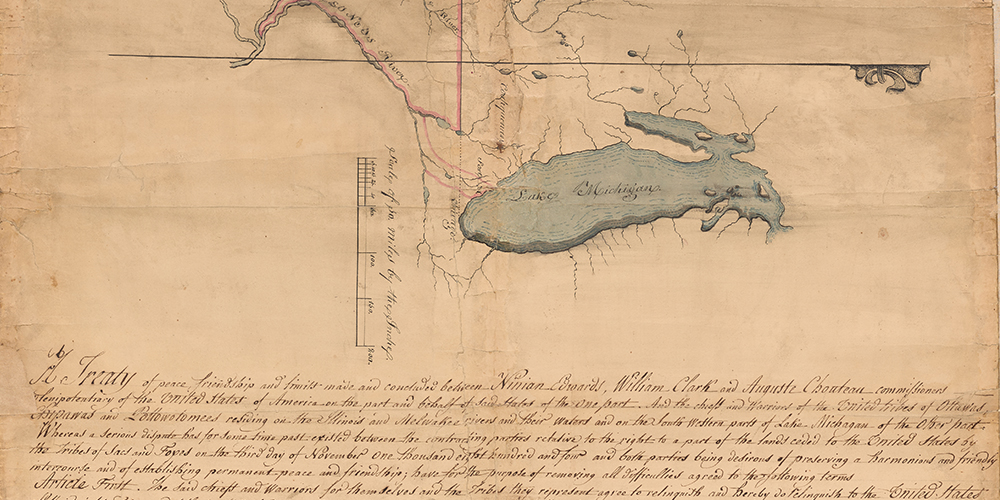
U.S. ContextSeminole War
War between U.S. and the Seminole. The Seminole were allies to the Spanish, and frequently crossed Spanish-U.S. border into Florida to avoid U.S. aggression. The war ended with Andrew Jackson’s capture of Spanish Florida, although he was forced to return land to the Spanish. In spite of scandal and controversy, the war fueled Andrew Jackson’s popularity, and bolstered Jackson’s perspective that national security depended on removing Native people from their land.
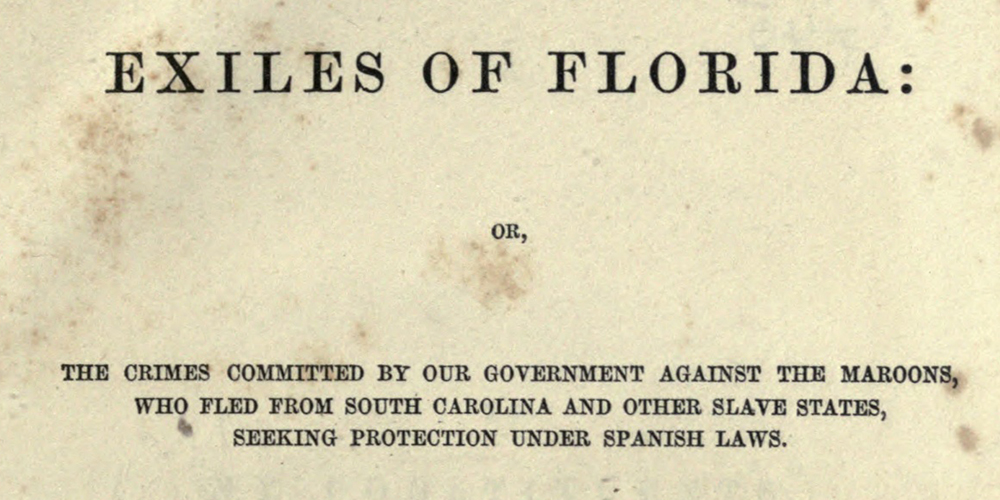
Native NationsTreaty With Peoria
Treaty signed between the U.S. and the Peoria Nation in which the Peoria ceded their land in Illinois and received 640 acres of land (which they already resided on) in Missouri. This treaty was an extension of a previous treaty created with the Kaskaskia, Mitchigamia, Cahokia, and Tamarois nations in 1803. This treaty would move the Peoria down to Missouri as well as give them U.S. protection from other Native nations in the area.
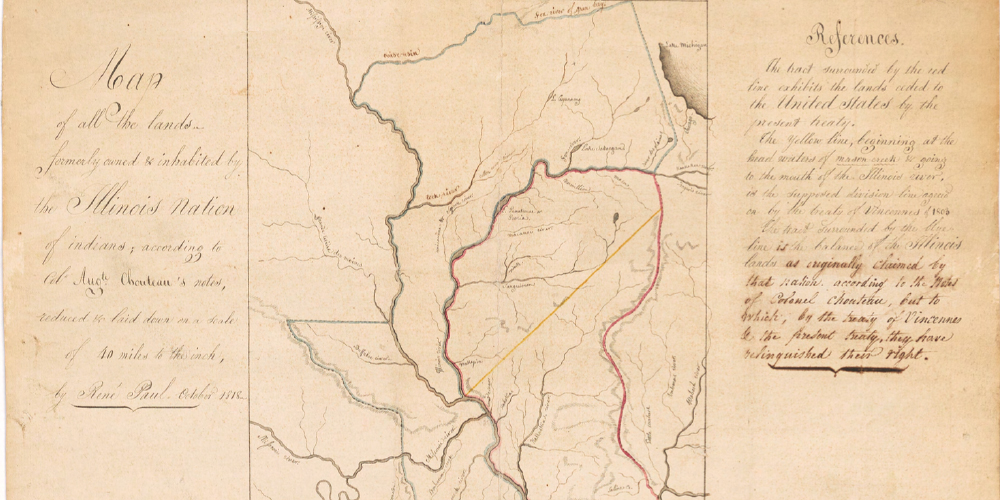
U.S. ContextAdams-Onis Treaty
After the U.S. returned Florida to Spain in response to international outrage over the unsanctioned conquest of the territory and military trial and execution of British citizens, John Quincy Adams and Don Luis de Onís negotiated the purchase of Florida by the US. This opened up more land for U.S. expansion.

Native NationsTreaty of Edwardsville/Treaty of Fort Harrison
These treaties, made between separate bands of the Kickapoo nation and the United States government moved the Kickapoo from their lands in what is currently Indiana and Illinois westward over the Mississippi river to Missouri. Two renegade bands of the Kickapoo did not accept the treaties and stayed in Illinois until 1834 when they were eventually persuaded to leave. By removing the Kickapoo, one of the last nations to have occupied Illinois, the U.S. government could more easily persuade settlers to move west into the newly-created state.
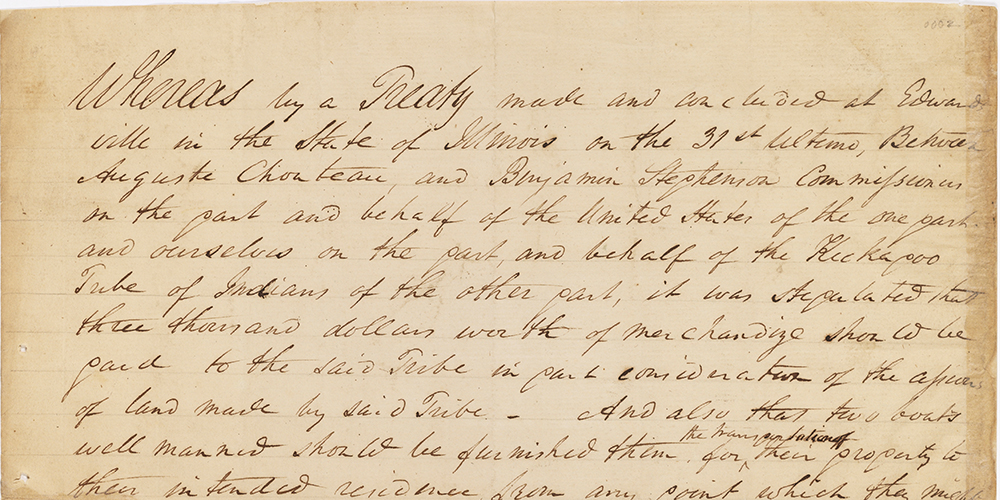
Native NationsLawrence Taliaferro becomes a diplomat between Native nations and United States
Accompanying the Fifth Infantry into what is currently Minnesota, Taliaferro began his career as Indian agent to the Dakota and Ojibwe nations. Taliaferro believed in white supremacy, and spent time, energy, and some of his own money to try and persuade Native nations to adopt American lifestyle practices. He also owned and traded enslaved people.
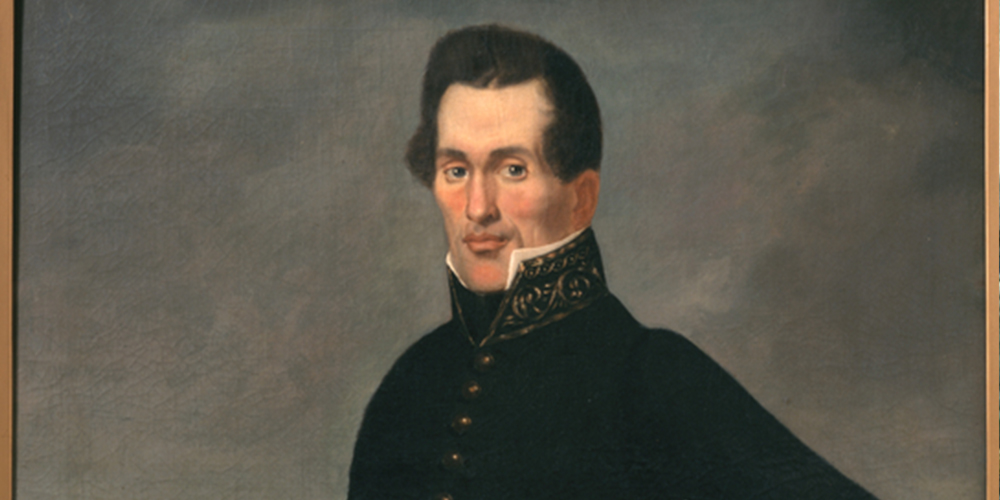
U.S. ContextChumash Rebellion
Before mission secularization in the 1830’s, California missions were run by Catholic priests and meant to evangelize the Native people kept there. Three of these missions were on the ancestral lands of the Chumash, a tribe native to southern California, who, in February of 1824, started a revolt against the soldiers at the missions who had been abusing them. This revolt had less to do with evangelism (the Chumash respected the Spanish friars), and more to do with the awful treatment they endured in the missions at the hands of the soldiers, and is an example of how important a role religion played in relations between white settlers and Native peoples.
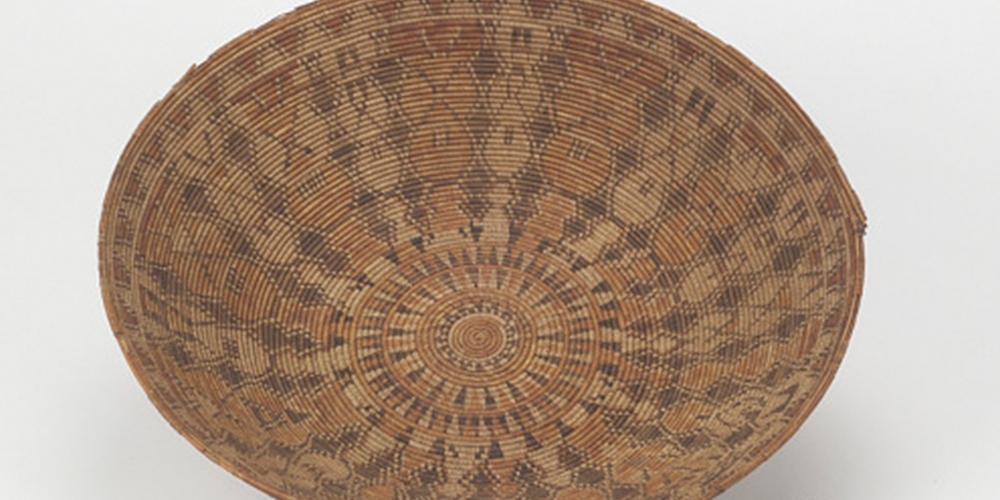
FoundersModern Knox County Established
The number of American settlers in western Illinois grew large enough for them to establish the modern Knox County out of Fulton County. This was possible because Native Nations had been forced out in previous years.

Native NationsTreaties at Prairie Du Chien
In an attempt to settle tensions between Native Nations in the Midwest, multiple treaties were signed between the United States and the Sauk, Meswaki, Dakota, Omaha, Iowa, Oto and Missouri in Prairie Du Chien. The first treaty was signed in 1825, in which the United States tried to map out boundaries between different Native nations. The U.S. had no power to enforce the boundaries, however, so the treaty had little usefulness to anyone involved.
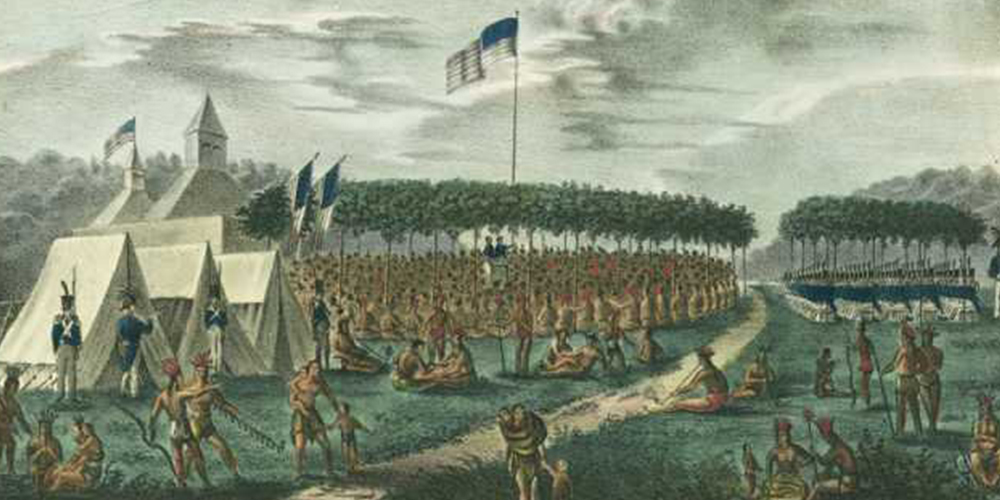
FoundersGeorge Washington Gale founds the Oneida Institute in New York
The Oneida Institute in Utica, New York, was George Washington Gale’s first attempt to open a manual labor college. The college’s staff were overwhelmingly anti-slavery, and Gale would apply the lessons he learned in running Oneida to the organization of Knox College.

U.S. ContextNullification Crisis
Nullification was the idea that if a state disagreed with a piece of federal legislation, it could refuse to implement that law. This would have severely weakened the power of the U.S. presidency, and was one of the reasons Andrew Jackson acted so forcefully in Georgia’s interests regarding the removal of Native people from the Southeast: he wanted Georgia’s support against those who supported nullification.
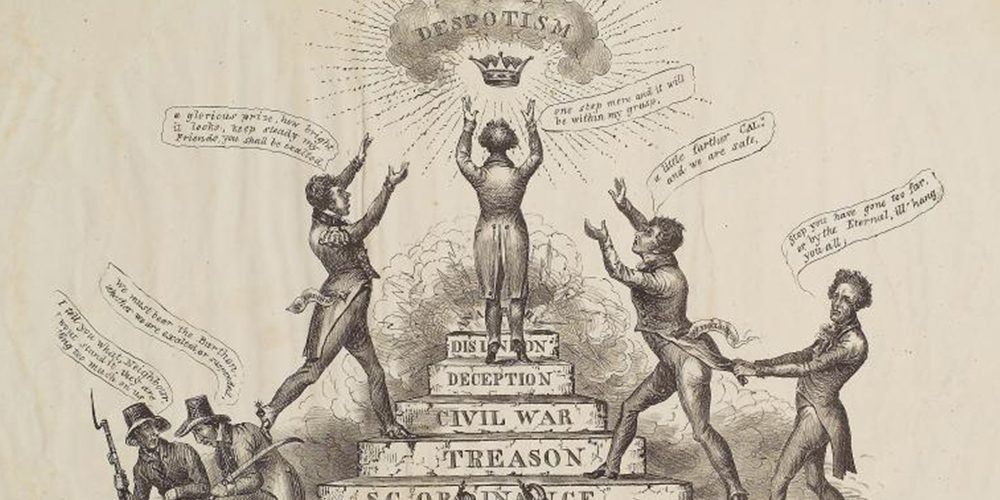
U.S. ContextThe Cherokee Constitution
In 1827 the Cherokee established a constitution. This signaled the nation’s commitment to protecting its political interests and its territory, both of which angered Georgians who wanted access to Cherokee land to expand the reach of white-governed slavery.
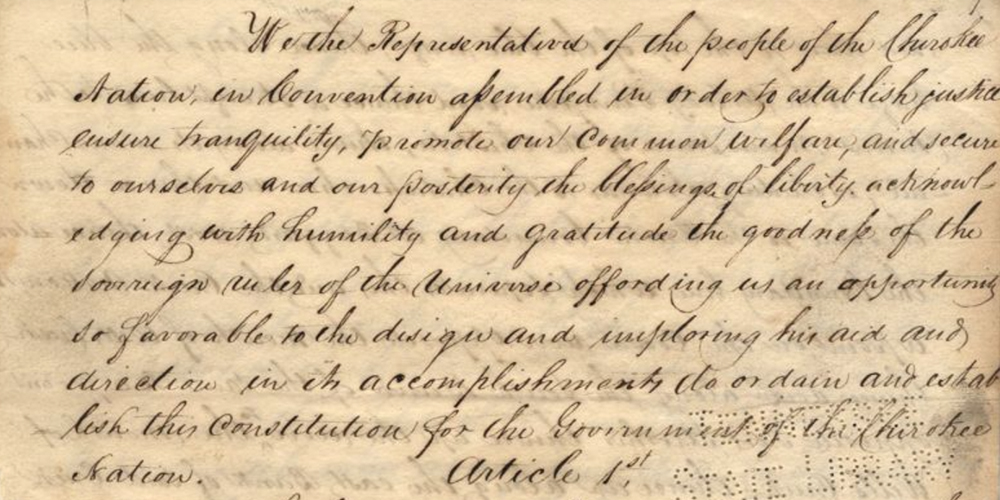
U.S. ContextAndrew Jackson is elected to the Presidency of the United States
Jackson was elected on a promise to open up land to enslavers in the South who wanted to get their hands on Native land. His election was the precursor to the passing of the Removal Act in 1830.

U.S. ContextGeorgia Extends State Law
On December 20, Georgia passed a law extending state jurisdiction over Cherokee land. This was intended to force Andrew Jackson’s hand on the matter of removing Native nations west of the Mississippi.
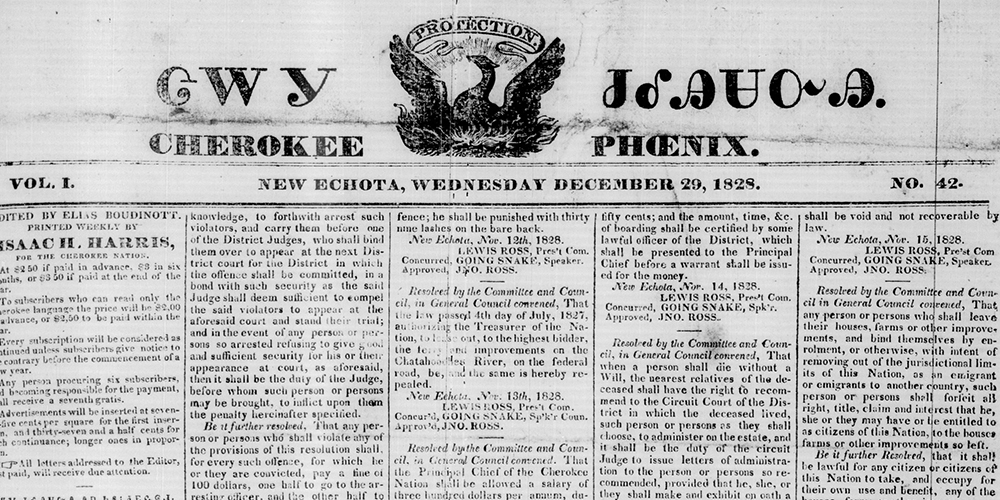
U.S. ContextIndian Removal Act
Removal was Andrew Jackson’s chief policy toward Native nations during his presidency, and formalized the federal government’s long-standing approach toward relationships with Native people. The Removal Act, passed in 1830, allowed the federal government to negotiate and create treaties for the removal of Native nations to the far side of the Mississippi in exchange for the financial compensation. The U.S. negotiated individual treaties with each removed nation, but often employed underhand tactics to gain a nation’s assent, as well as deploying force.

Material CultureCatlin's Paintings of Native Nations
In 1830, George Catlin, an American painter, began his journey west of the Mississippi. Between 1830 and 1836, Catlin visited fifty nations and documented these visits in paintings. In total, there are over 400 portraits and landscapes created by Catlin, all depicting the lives of those he visited. It is important to note however, Catlin’s works center the white gaze and are not completely accurate depictions of Native people.
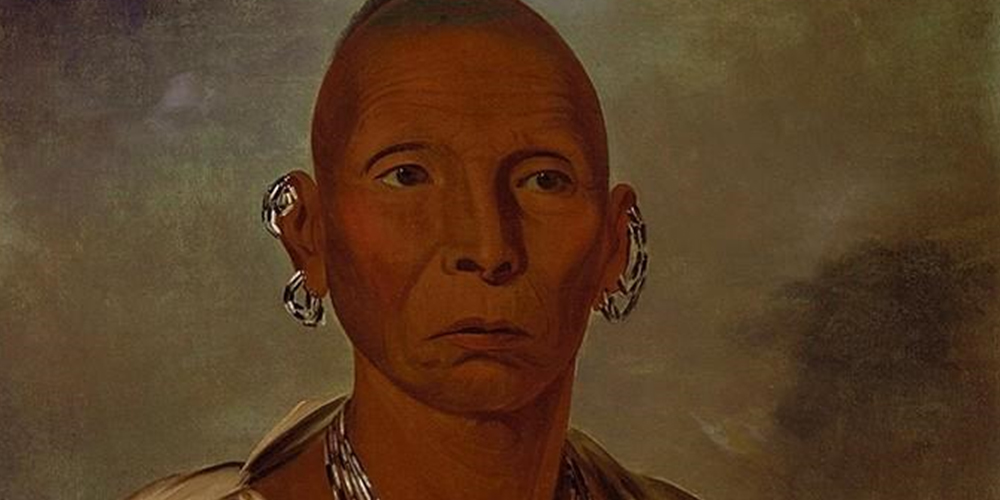
U.S. ContextCharles Grandison Finney's revival meetings kickstart the Second Great Awakening
The Second Great Awakening was a Protestant revival in the early 19th century United States that was characterized by impassioned and public preaching, as well as widespread social reform. This movement started in upstate New York with the spirited preaching of Charles Grandison Finney, who promoted progressive views such as abolition and equal education for both women and African Americans. One of Finney’s biggest inspirations was George Washington Gale, one of the founders of Galesburg.
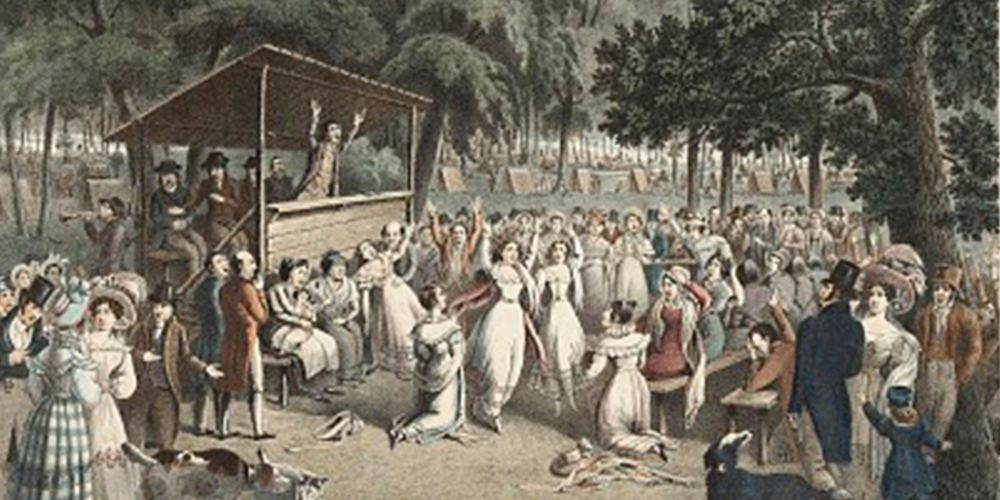
U.S. ContextCorn Treaty
This treaty stated that the Sauk must move their homes to the western side of the Mississippi and could not cross to the eastern side without permission from the US government. By signing this treaty, Black Hawk was forced to ratify the treaty of 1804 and to recognize his rival, Keokuk, as a leader. This treaty was also signed by General Gaines and Governor Reynolds. Because of this treaty, the Sauk were unable to plant as many crops as usual, leading to food shortages during the following winter.
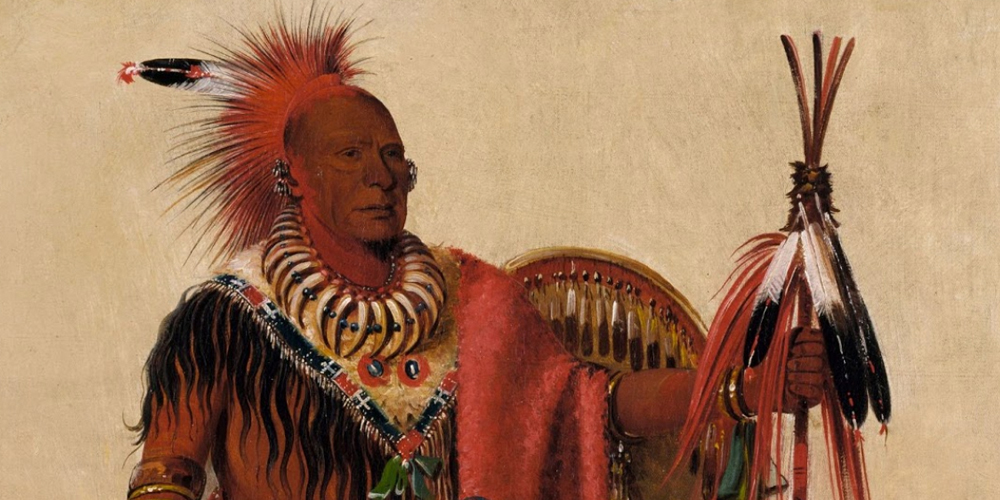
Native NationsBlack Hawk War
Black Hawk led a band of Sauk, Meskwaki, Ho-Chunks, and Kickapoos across the Mississippi River with the intent to return to Saukenuk, a Sauk Village, to plant crops. In response to this, Governor Reynolds began forming militias of settlers to pursue Black Hawk’s group. The settler militias misinterpreted Black Hawk’s intentions as a threat and exaggerated the number of people in Black Hawk’s band. The band traveled northward in an attempt to escape bloodshed. When they attempted to cross the Mississippi, Illinois militia men attacked them. Black Hawk’s forces were outnumbered and had to surrender after the massacre at Bad Axe where 150 Native people were killed.
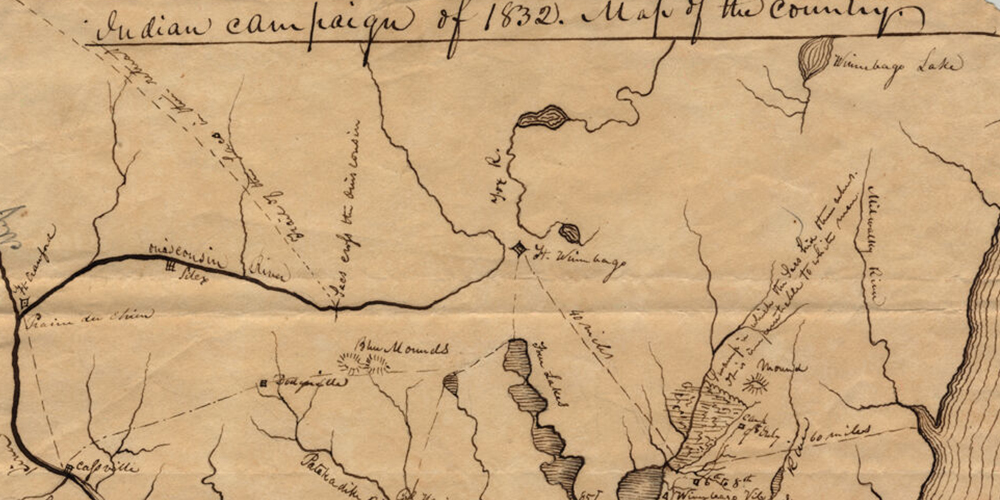
FoundersCommission to acquire land in Illinois and Indiana formed
In the wake of the Black Hawk War, U.S. Secretary of War Lewis Cass sent commissioners Jonathan Jennings, John Davis, and Mark Crume to meet and negotiate with the Potawatomi and Miami nations, with the goal of securing claims to their land in Illinois and Indiana.
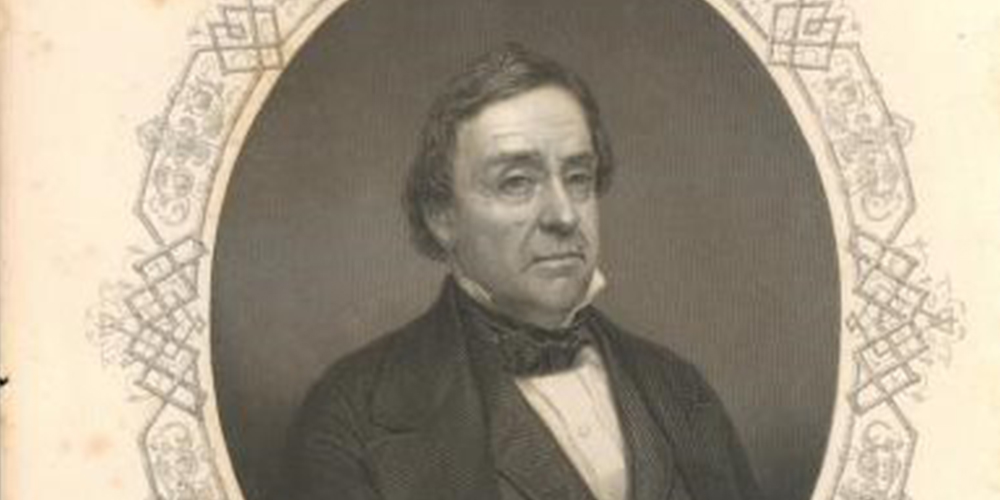
FoundersThe Students at the Oneida Institute found an anti-slavery society
Inspired by William Lloyd Garrison, students at the Oneida Institute formed an anti-slavery organization. This was very much in keeping with George Washington Gale’s own anti-slavery commitments, which shaped his vision to found a college further west.
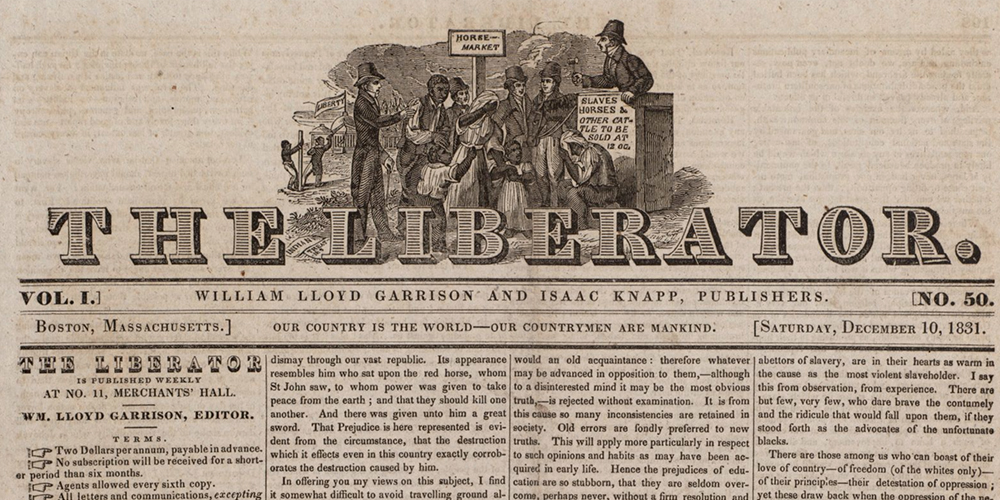
FoundersGeorge Washington Gale passes off Oneida Institute to Beriah Green
George Washington Gale handed governance of the Oneida Institute over to Beriah Green, freeing Gale to focus on expanding Christianity in the west. Gale’s religious thinking was brand new. Calvinists at the time believed that humans were fundamentally bad and most couldn’t get into heaven, whereas Gale believed that everyone, including African Americans but excluding Native people, could get into heaven.
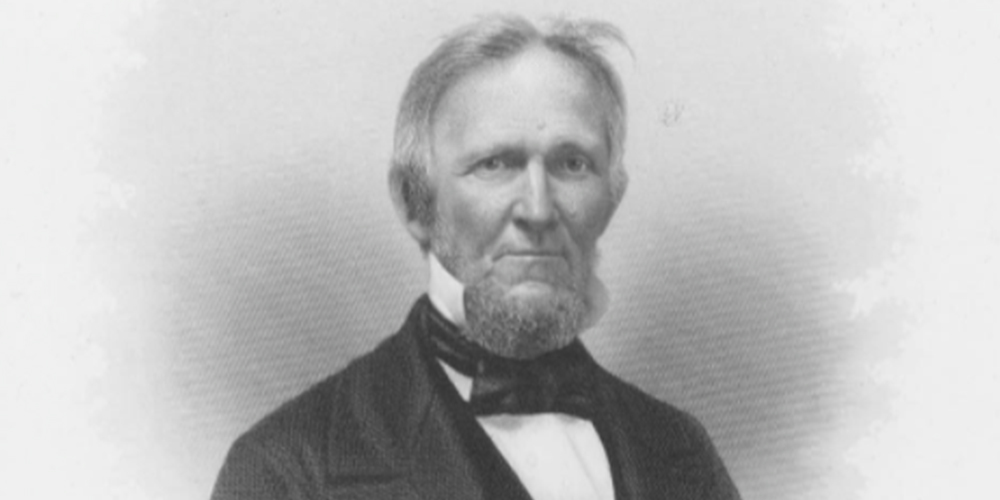
Native NationsTreaty of Chicago
The Council of Three Fires (Ojibwe, Odawa, and Potawatomi) ceded 5 million acres of land, including all remaining land in Illinois, to the U.S. government in exchange for financial support and claims over new land in the west. The government called for their relocation to a reservation west of the Mississippi River and stated that they “should remove to the country thus assigned to them as soon as conveniently can be done,” beginning the formal process of forcibly removing the Potawatomi nation from Illinois.
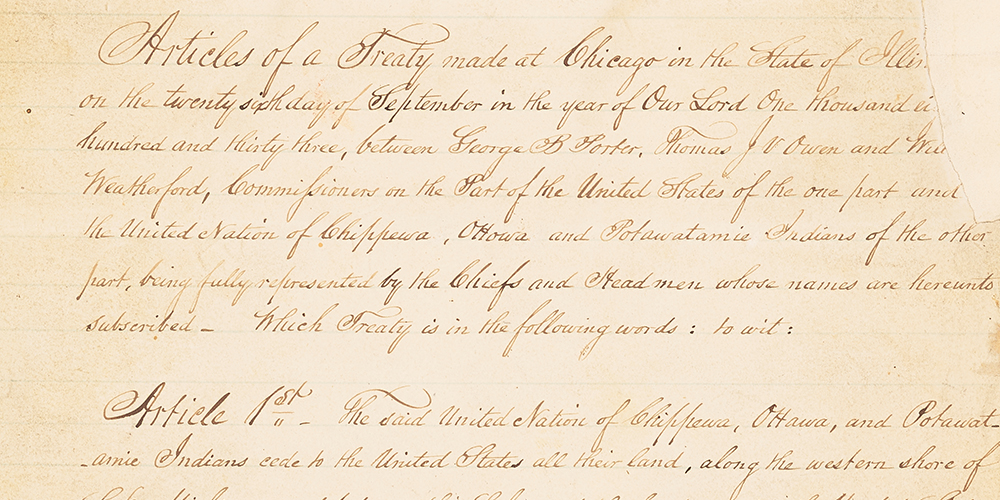
Native NationsRemoval of the Prairie Potawatomi from Illinois
A harsh winter and anger over the Black Hawk War caused settlers to demand the removal of Native nations from Illinois. To avoid forced removal west of the Mississippi River, the Prairie band of Potawatomi vacated their land in Illinois and sought refuge at the Indian agency in Logansport, Indiana. From Logansport, they would eventually be forcibly relocated to a reservation in Kansas in a march known as the Potawatomi Trail of Death. More than 40 Potawatomi, mainly children, died on this march.
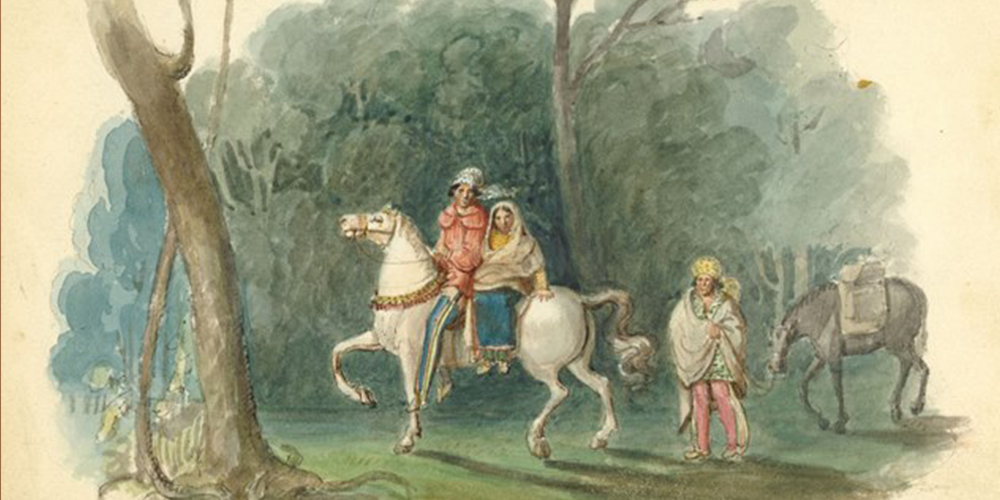
U.S. ContextMexican Secularization Act
Starting in 1824, the fairly newly-independent Mexico reclaimed the land that the California Indian Missions were on and exiled the Franciscan priests who were stationed there. This land was originally supposed to be redistributed the Mission Indians who lived there, but most of it ended up being split among Spanish-American settlers who turned these lands into ranchos. Only a small portion of Mission Indians got any land out of this act that was supposed to help them. This is similar to the land that belongs to the Native people in what’s currently western Illinois being taken from them.
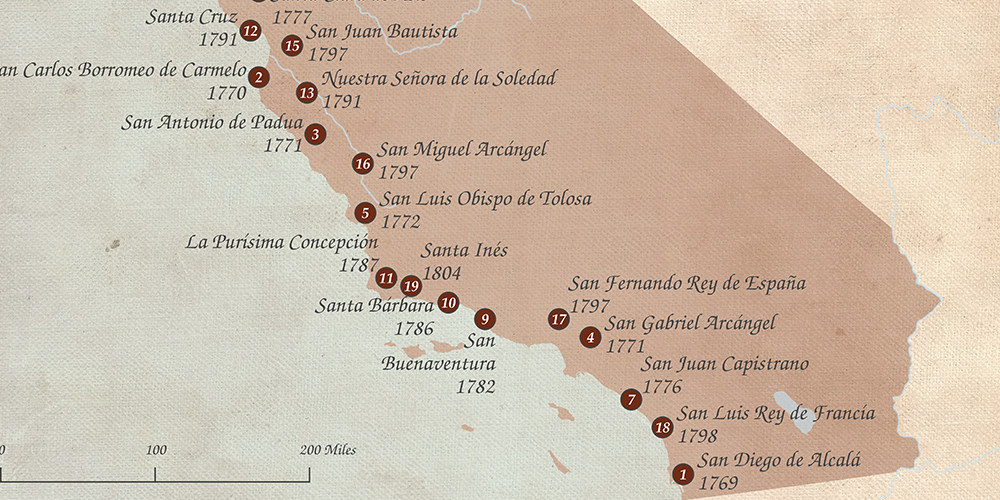
FoundersExploring Committee and Purchasing Committee sent out to the West by George Washington Gale
George Washington Gale sent two committees west to look for and purchase land in the military tract of Illinois. The committees decided on Knox County due to it being the first decently sized plot of land they found, as well as Gale thinking that God had given this plot of land to them for the purpose of founding Knox College. This land was purchased from the federal government.
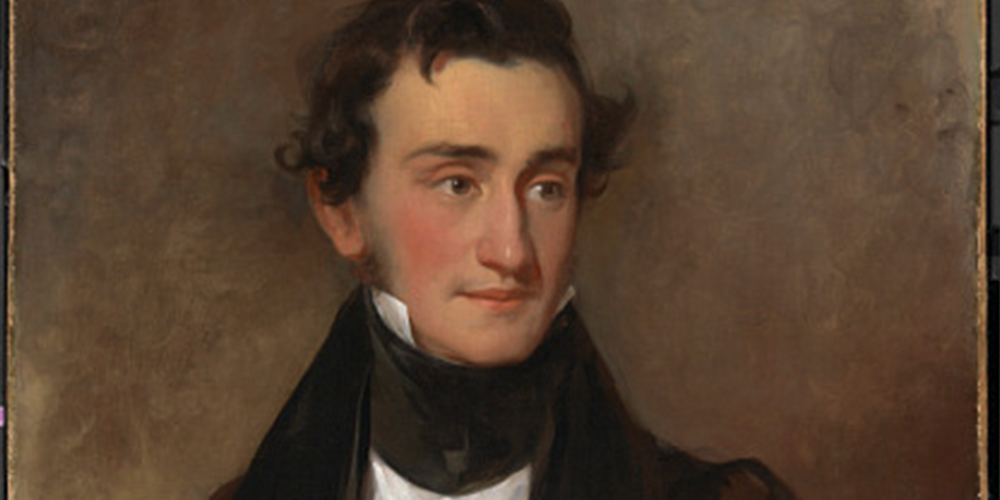
FoundersGeorge Washington Gale draws up plans for Galesburg
George Washington Gale’s original plan for the organization of Galesburg was made in Whitesboro, New York before the founders moved out to what we currently call Illinois. The plan called for four streets to form a square. The streets were South, Academy, North, and Seminary.
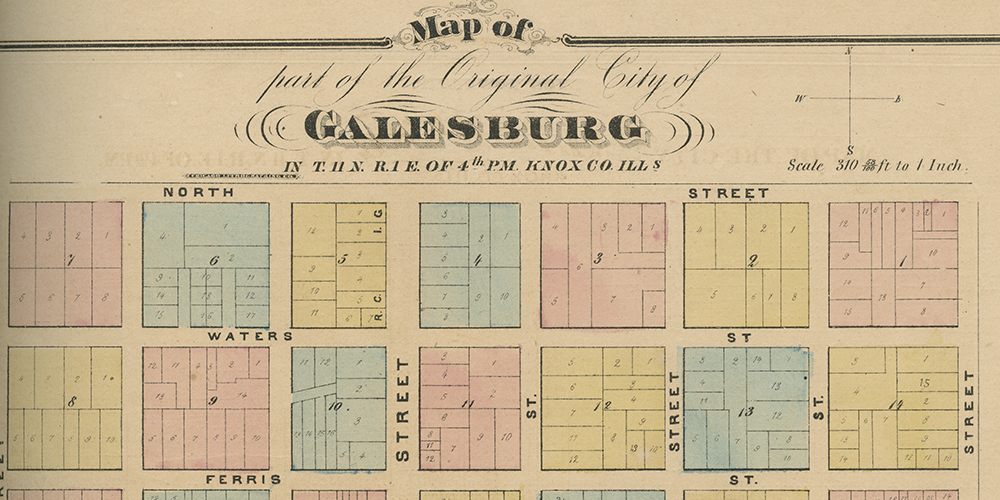
FoundersLog City built
George Washington Gale and the first American migrants to what is currently Galesburg built Log City. Log City was a series of cabins in which migrants lived while setting up permanent spaces for Galesburg and Knox College. Log City was possible due to the military tract of land.
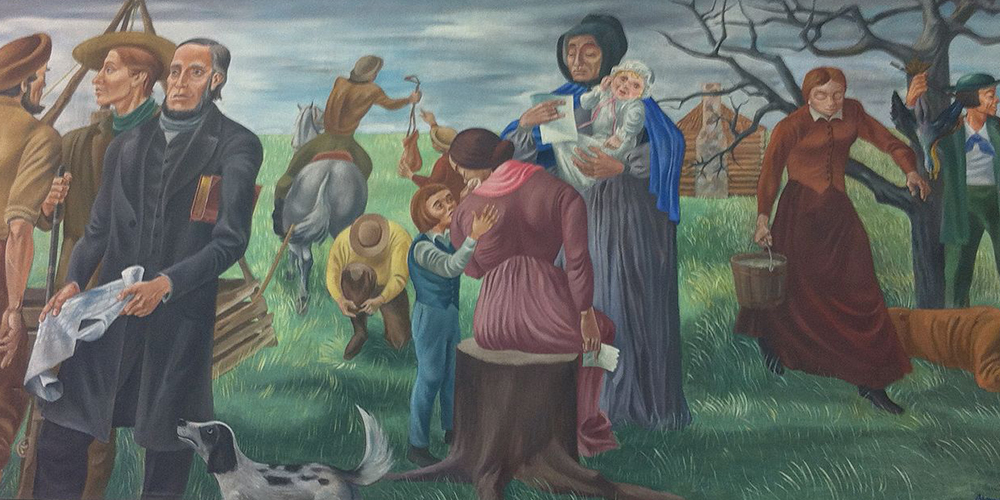
FoundersLocal Anti-Slavery Society Formed
On July 4, 1837, a chapter of the American Anti-Slavery Society was formed in Galesburg. The vast majority of the people in Galesburg were against slavery, and Galesburg itself was a stop on the Underground Railroad. Several of the Founders - including George Washington Gale - played important roles in hiding formerly enslaved people and helping them continue on their journey, sometimes to Canada. In addition, there was a youth chapter of the American Anti-Slavery Society in Galesburg. One of their activities as a youth chapter was pledging not to use goods created by enslaved people.
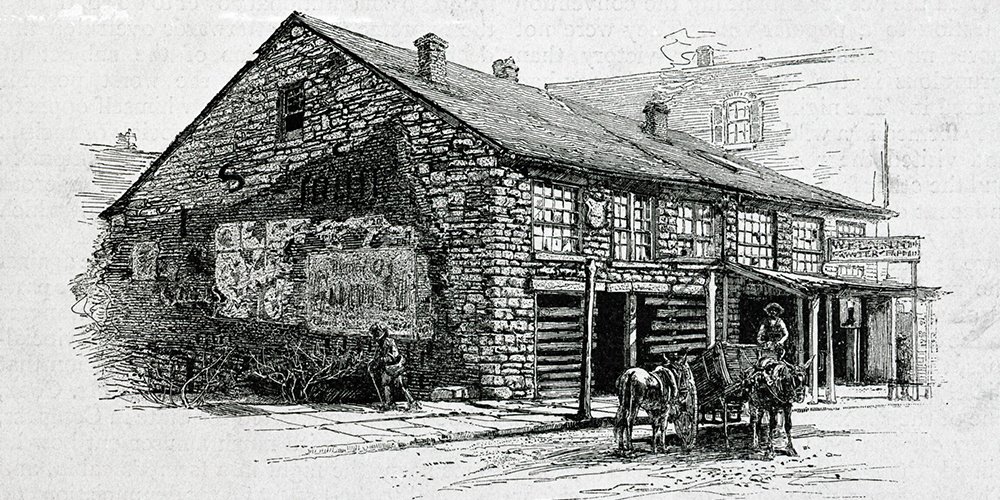
FoundersKnox College and Galesburg Founded
Knox College and Galesburg were founded in 1837.
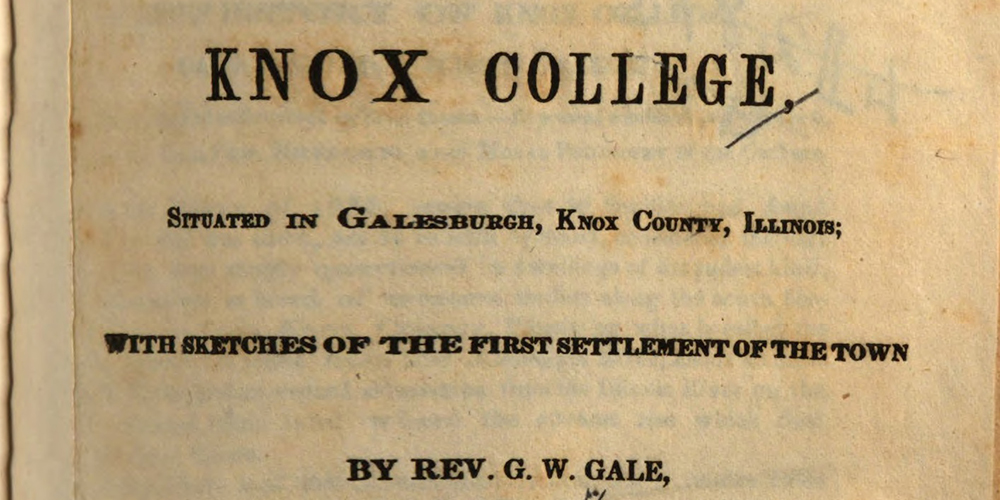
FoundersFemale Seminary Founded
A school to prepare women for mission work, teaching, or domestic labor was founded by the community. This was a radical idea at the time, and helped to bring more settlers to Galesburg.
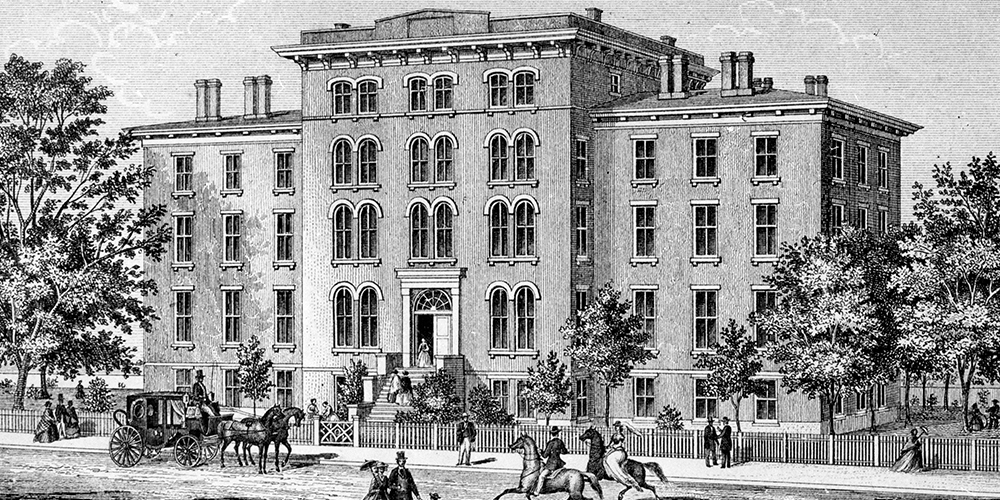
FoundersKnox Academy Founded
A school for children who might one day become Knox students was founded. The school was created to convince more families to move west from settled American territory.
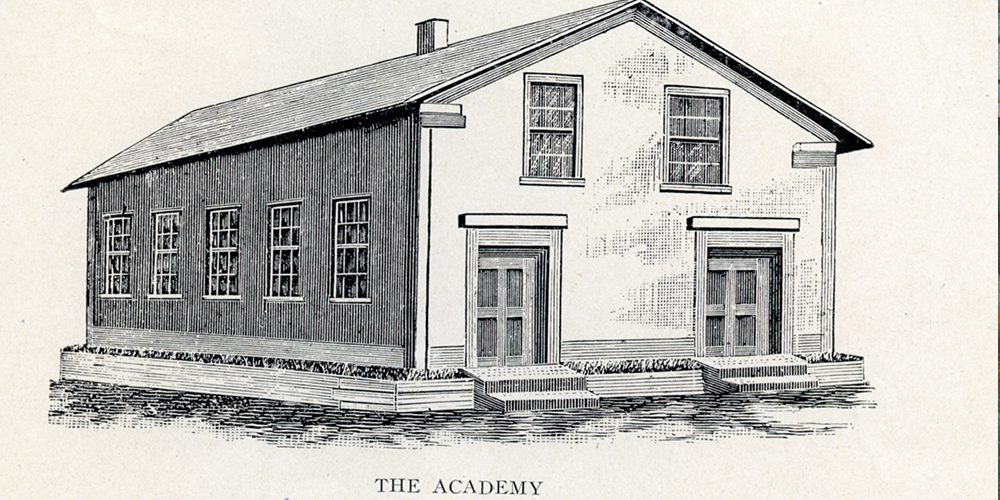
FoundersSam Holyoke arrives with his family as a child to settle in Log City
Sam Holyoke arrived with his family to settle in Log City. He lived in Log City until his father was able to build one of the first houses in town. Later, when he was an adult, he sketched what he could remember of what Log City looked like.
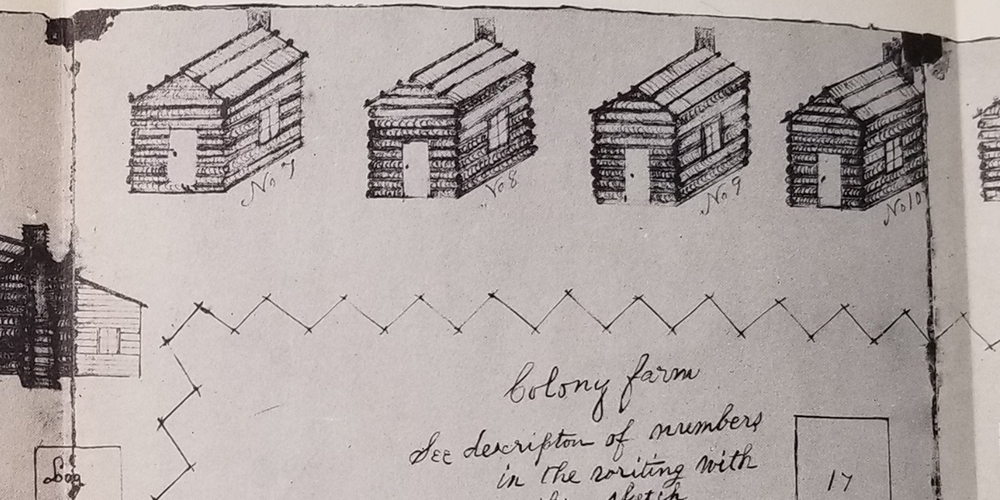
Native NationsLand Cession Treaties with the Ojibwe & Dakota
In 1837, Lawrence Taliaferro helped pressure the Ojibwe and Dakota nations in the first major land cession of these two nations. The nations were offered money, supplies, and hunting rights in return for ceding land. Often the amount offered was not paid in full or the money was given late. This devastated the Ojibwe and Dakota nation by collapsing their presence in the fur trade and damaging their economic ability in the midwest region. The land ceded was in the places we currently call Wisconsin and Minnesota.

Native NationsTreaty of 1838
In 1838, the Myaamia nation ceded all lands south of the Wabash River to the United States. The Myaamia knew that further conflict with the United States was imminent and finally considered removal from their homelands as a means of surviving as a nation.

FoundersOpening of Knox College
Knox College did not open its doors to students until 1841, at which time it enrolled sixteen white men. This four year gap between the founding and the opening was due to an economic depression that hit the region, which made Knox College struggle financially.
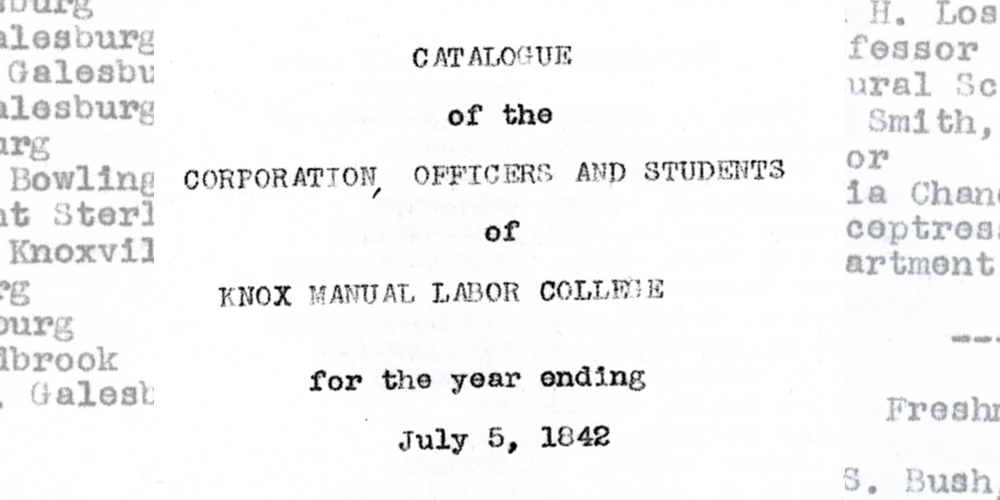
FoundersGalesburg as a Village
This year marks when Galesburg became incorporated as a village. During the year of 1841, the population of Galesburg grew to around 500 settlers.

U.S. ContextRailroad Extends to Galesburg from Chicago
This is the first time that the railroad extended from Chicago to Galesburg, which set up the town and Knox College financially.


